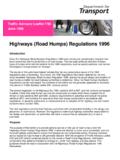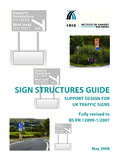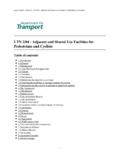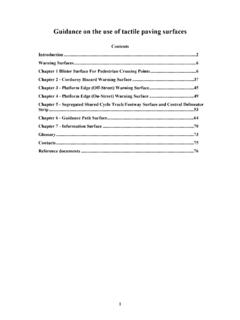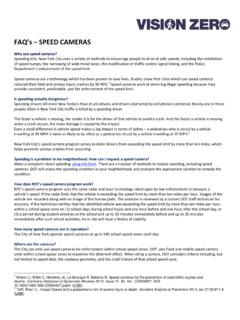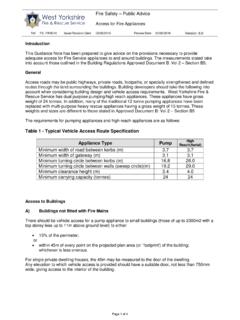Transcription of 20 mph speed limits and zones - UK Roads Ltd
1 Traffic Advisory Leaflet 9/99 June 1999 20 mph speed limits and zones Introduction The first three 20 mph speed limits forming zones were implemented in Sheffield, Kingston upon Thames and Norwich, in January 1991. Since then, around 450 zones have been installed in the UK. Until June 1999 specific consent from the Secretary of State was needed. The legislation has now been changed, and local traffic authorities no longer need to obtain the consent of the Secretary of State before implementing 20 mph speed limits . In addition to changes in the Road Traffic Regulation Act 1984, amendments have been made to the Traffic Signs Regulations and General Directions (TSRGD), the Highway (Road Humps) Regulations, and the Highway (Traffic Calming) Regulations; and the Road Humps (Scotland) Regulations and the Roads (Traffic Calming) (Scotland) Regulations.
2 These make possible two different means of implementing 20 mph speed limits . Broadly, these are: use of speed limits , indicated by terminal and repeater signs alone; a zonal approach using terminal signs together with suitable traffic calming measures to provide a self enforcing element. The purpose of this leaflet is to provide advice on how and where to implement 20 mph speed limits and 20 mph zones , to help in meeting the objectives of the Government White Paper, "A New Deal for Transport: Better for Everyone" and the requirements for Local Transport Plans. Background The use of 20 mph speed limit zones was intended to address the serious problem of child pedestrian accidents occurring in and around residential areas, and so was initially limited to these areas.
3 Subsequent research has shown that the risk of a child being involved in an accident has reduced by about two-thirds where 20 mph zones have been installed. 20 mph zones are no longer confined to residential areas. There are a number of town centre zones . In the "Bypass Demonstration Project", four of the six towns had 20 mph zones in their central areas. A small number of 20 mph zones have also been used in rural areas, an example being in Epping Forest. Epping Forest 20 mph zone Application It will be for local authorities to determine whether speed limits or zones should be used. They will need to decide whether the proposed type of speed limit is appropriate to the area, and beneficial in road safety and environmental terms.
4 Equally important is that the form of speed limit chosen does not require unreasonable levels of enforcement by the police. 20 mph speed limits by signs alone would be most appropriate where 85th percentile speeds are already low and further traffic calming measures are not needed. 20 mph zones should be used where excessive speeds occur, and where traffic calming measures would be needed to ensure speeds are at or below 20 mph. 20 mph zones would be particularly appropriate where there is an existing record of accidents to children occurring over an area, or where concentrations of pedestrians and/or cyclists exist or are anticipated. They can help to protect children walking and cycling to and from school, and may encourage other children to walk or cycle.
5 With new road layouts, where suitable features can be included in the design, the preference should be for 20 mph zones . Design Bulletin 32 and the companion guide "Places, Streets & Movement" provide further advice. Signing 20 mph speed limits require terminal signs and repeater signs to diagram 670 (TSRGD). Terminal signs, to diagram 670, on trunk and principal Roads within 50m of a street lamp must be illuminated. The terminal signs should be placed on both sides of the carriageway to form a gateway. Additional emphasis at the start of the speed limit can be provided by yellow backing boards. Where a limit starts near to a junction, great care must be taken in siting the signs to ensure that they are clearly visible to turning traffic.
6 Advice on the spacing of repeater signs for 20 mph speed limits is given in Traffic Advisory Leaflet 1/95. Diagram 670 Road humps will need to be signed separately, and appropriately lit, where a 20 mph speed limit is designated by diagram 670. Whether other traffic calming measures need to be signed will depend on the circumstances, but diagram 670 cannot be relied upon to warn of their presence. 20 mph zones require signs to diagram 674 and 675 (TSRGD) placed on both sides of the carriageway. It has become recognised that diagram 674 (TSRGD) provides a warning that drivers are entering an area where they can expect to encounter closely spaced traffic calming measures. For this reason, the road hump and the traffic calming regulations do not require additional signs to warn of individual traffic calming measures in the zone.
7 Signs to diagram 674 do not need to be illuminated. Traffic Advisory Leaflet 2/93 gives detail on signing. Diagram 674 Exit from 20 mph zone showing signs to Diagram 675 Changes to the General Directions of the Traffic Signs Regulations and General Directions provide that diagram 674 may be used only where the speed limit is enforced by the presence of speed controlling features not more than 100m apart. speed controlling features may be summarised as road humps, chicanes, pinch points, gateways, narrowings and bends. Culs de sac not longer than 80m would not require any additional measures. The Traffic Signs General (Amendment) Directions 1999 should be consulted for a precise interpretation of what constitutes a speed controlling measure.
8 Research The Transport Research Laboratory (TRL) reviewed results from 250 zones in England, Wales and Scotland. The outcome is described in TRL Report 215 - "Review of Traffic Calming Schemes in 20 mph zones ". The main findings indicated that average speeds reduced by 9 mph, annual accident frequency fell by 60%, the overall reduction in child accidents was 67%, and there was an overall reduction in accidents to cyclists of 29%. Traffic flow in the zones was reduced by 27%, but flows on the surrounding boundary Roads increased by 12%. There was generally little accident migration to surrounding Roads . Entry to 20mph zone TRL have also carried out a review of low speed -limit zones in this country and abroad, where physical measures have not been used extensively to influence speed , and reliance is placed primarily on signing.
9 The results of this review are reported in TRL Report 363 - "Urban speed Management Methods". The review has indicated that using 20 mph speed limit signs alone, without supporting traffic calming features, led to reductions in 'before' speeds, on average, of 1 mph. Specific cycling facilities where needed in a 20 mph zone Data from vehicle speed surveys of a range of Roads in Great Britain show that a high proportion of drivers exceed posted speed limits . A study of the effects that 20 mph zones may have on the activities of residents in a zone is being undertaken. The full results of this study will not be available for some years. Interim outputs indicate that whilst residents tend to be enthusiastic about the proposed imposition of 20 mph speed limits , they become less supportive following implementation if the speed limit is not observed.
10 The Scottish Office is monitoring the effectiveness of advisory 20 mph speed limits in residential areas and around schools. The results of the trials should be available in the Autumn of 2001. Zone entry with a build out Enhanced gateway treatment, Bury St. Edmunds Design Advice 20 mph speed limits without self-enforcing features have the attraction of being relatively inexpensive to implement. However, regard must be given to the 'before' speeds, because the higher they are the less likely speeds will be reduced to 20 mph. It will be important that the local police are consulted at the outset, to obtain an understanding of the level of enforcement that could be applied and how effective that might be in ensuring a significant reduction in speed .
